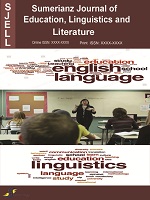Sumerianz Journal of Education, Linguistics and Literature

Online ISSN: 2617-1201
Print ISSN: 2617-1732
Quarterly Published (4 Issues Per Year)
Journal Website: https://www.sumerianz.com/?ic=journal-home&journal=33Archive
Volume 4 Issue 2 (2021)
Traveling With the Greek Language through Time
Authors : Evangelos Panagiotis Kaltsas
DOI : doi.org/10.47752/sjell.42.58.61
Abstract:Introduction. A language is the fundamental characteristic of a nation’s identity. It can unite the members of an ethic team and set them apart from the members of other ethnic teams. Aim. In this current review, the study presents the evolution of the Greek language from the ancient times, all the way up to today. Methodology. The study’s material consists of articles related to the topic, found in Greek and International και databases, the Google Scholar, and the Hellenic Academic Libraries (HEAL-Link). Results. The Greek language has been used since the third millennia B.C.. During the ancient times, it was the most widely used language in the Mediterranean Sea and South Europe. Until the fifth century B.C., the Greek language was a total of dialects. The Attica Dialect stood out from this dialectical mosaic. Then came the Hellenistic Common, which became the hegemonic language, the lingua franca of the "universe". The Hellenistic Common evolved to the Middle Ages Greek, and later the New Greek (fifth century A.D. - today). Besides, the creation of the New Greek state resulted to the gradual formation of the New Common, which will become the modern New Greek Common, under the effect of the scholar language. Conclusion. The Greek language keeps borrowing and assimilating words from other languages today, just like it did in the past, remaining unbroken for forty centuries.
Teachers’ Professional Development and E-Learning
Authors : Kaskani Aliki ; Dimogeronta Panagiota
DOI : doi.org/10.47752/sjell.42.48.57
Abstract:Teachers’ professional development is a process in which teachers constantly transform their practice through their participation in training and educational programs, among other practices. This process is significant, since teachers have to face numerous challenges, due to the fact that education is a dynamic process. The advances in technology have enabled teachers’ professional development through e-learning, which is supported by various studies to be an effective means. The aim of this paper is to examine the importance and usefulness of e-learning.However, teaching students with special learning needs is the first major area in which teachers identify their educational needs, followed by teaching in a multicultural setting and student counselling. In addition, EFL teachers acknowledge, understand and accept the important role of e-learning in facilitating, supporting and encouraging their professional development. Moreover, the access to resources of e-learning, the existence of skilled teachers’ educators and technical support, and the evaluation of the program were found to facilitate their participation in an e-learning training program.
Cleft Construction Is a Salient Feature in the ‘City of Glass’ a Novel by Paul Auster: A Stylistic Study
Authors : Hussam aldeen N. Hadi
DOI : doi.org/10.47752/sjell.42.40.47
Abstract:The present study is an attempt to investigate using the grammatical devices of cleft construction as a stylistic feature in the ‘city of Glass’ a post-modernist novel by Paul Auster. The purpose behind using cleft sentence is to highlight the element which is a part of the sentence and it is important for the author’s perspective. The construction of cleft sentence composes of a matrix clause headed by copula and relative or relative-like clause. Both (matrix and relative) reflect a simple logical proposal, That could’ve been conveyed in the consisting of a specific attribute without changing the truth circumstances. So this structure allows the writer focusing on the important element that he /she believes to reveal the creative use of language.



